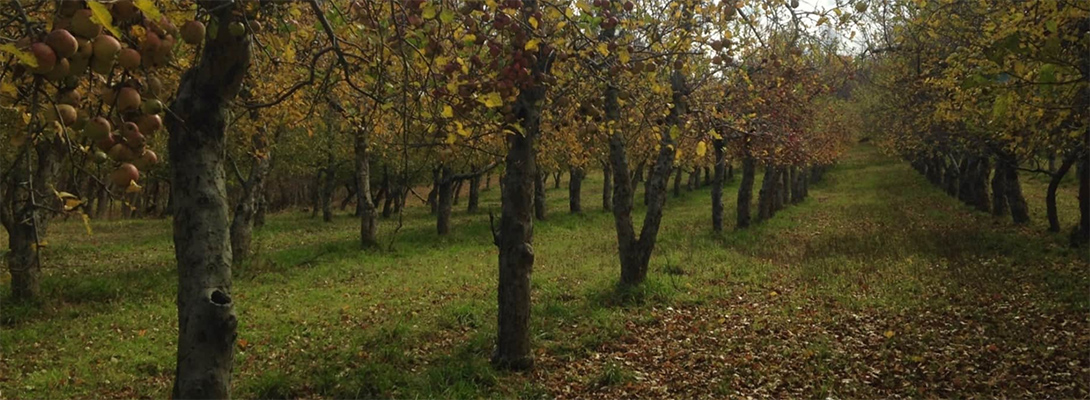
As early as 2013 Eric Asimov writing in the New York Times declared, "If the United States has not yet embraced the apple for drinking with such unabashed enthusiasm, make no mistake, an American cider renaissance is well underway." At that time when he wrote the column there were around 20 commercial cideries in New York State. Today there are more than 90.
Cider is a drink with a long history. Archaeological evidence proves that European and Asian cultures used apples to make a sort of cider as early as 6500 BC. The early version of that cider is very different from the sophisticated craft blends you will find today. Today a craft cider generally requires the use of several complementary types of apples to provide balance. Different types of apple juices from heritage apples provide aromatic, astringent, acid-tart, and neutral components to a blend. Many cider makers forage in the wilderness looking for wild apples or cultivate special "heritage" cider apples which have very different properties to the traditional dessert varieties we encounter in the aisles of the local supermarket.
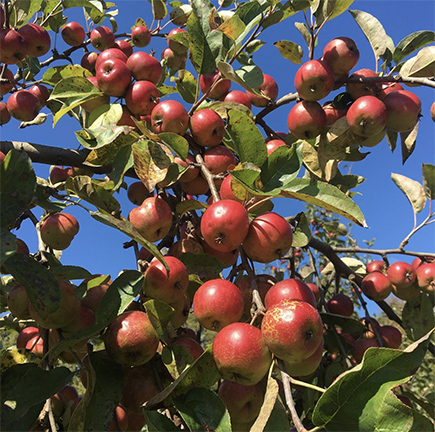 The history of cider in the United States originated with the birth of the nation and it is believed that a cider press was brought over on the Mayflower itself by our first pilgrim settlers. Most of the 17th and 18th century emigrants to America drank hard cider and its variants in their origin country. Legend has it that President John Adams began every day with a tankard full of hard cider.
The history of cider in the United States originated with the birth of the nation and it is believed that a cider press was brought over on the Mayflower itself by our first pilgrim settlers. Most of the 17th and 18th century emigrants to America drank hard cider and its variants in their origin country. Legend has it that President John Adams began every day with a tankard full of hard cider.
The early colonialists didn't trust the hygiene of water so cider and beer and brandy were used as more sanitary replacements. From 1620 through the 1700s cider was a staple of the American family table and according to Atlas Obscura, New England residents consumed an estimated 15 to 54 gallons of cider per year.
(Wickson apples at Eve's Cidery)
The taste for hard cider (as it is known in the US now to distinguish it from non-fermented apple juice also known as cider) continued into the 19th century. Cider's fall from grace in the US sprouted from a combination of immigration from Central and Eastern Europe, where beer is the traditional staple, and due to Prohibition where legend has it that overzealous prohibition officers decimated cider orchards across the country.
Today cider is on the rise. According to Beverage Daily, cider consumption in the US grew 8.4% in 2018 to $500 million in sales; compared to wine 2.4% or beer which decreased 2%. In his book The Cider Revival: Dispatches from the Orchard Jason Wilson quotes a figure of $1 billion as the value of global cider sales in 2017 (versus beer which is a $100 billion market).
Eve's Cidery is one of the pioneering American cider houses making artisanal cider from heritage cider apples. It was singled out with praise in Gabe Cook's fun book Ciderology: "Based in the Finger Lakes area of New York State, Eve's Cidery is a by-word for quality, orchard-based cider...(Eve's) expertise extends not just to the quality of the liquid in the bottle, but also the way the bottle is presented. The transparency of what goes into each cider-- the breakdown of varietals by percentage and full production notes-- is admirable, too. There's nothing to hide here-- only pride, honesty and integrity."
 Grape Collective talks with Ezra Sherman, who co-owns Eve's Cidery with his wife Autumn Stoscheck, about New York apples and the growth of craft cider.
Grape Collective talks with Ezra Sherman, who co-owns Eve's Cidery with his wife Autumn Stoscheck, about New York apples and the growth of craft cider.
Grape Collective: How did you start the business?
Ezra Sherman: The business was started by my wife about 18 years ago. She started it when she was 22. She was the youngest person in New York State at the time to get a farm winery license. Her name's Autumn Stoscheck. And I joined about 13 years ago.
Where is the cidery?
We are located about 20 miles south of Ithaca. It's near our house and near some of our orchards in Van Etten, New York. It looks like... If any of your followers have ever read The Hunger Games?
I always say it's District 12. It really looks like... It's the edge of the Appalachian Mountains where we are, even though it's kind of on the edge of the Finger Lakes as well. It looks like that District 12 that Katniss was from, in Pennsylvania, I think.
And what are the apples that you work with?
So we grow only for cider now, and all of our ciders now are made just with our apples we grow here. We grow a lot of cider-specific apples. For example, this is a Kingston Black. That's the sort of a renowned cider variety. This is Ellis Bitter. This is Wickson Crab. This is a sharp. And this is a Medaille d'OR. This is a French bittersweet. These two Kingston Blacks are bittersharp.  And so how many different varietals of apples do you-
And so how many different varietals of apples do you-
Oh, we say like 40. We have some primary varietals and then we have a smattering of a lot that we're experimenting with.
And how many trees do you have?
Oh boy. We have about eight acres planted in Van Etten, where we live, and about 12 acres planted in Newfield. Different systems. So some are planted on trellis, some are larger-size trees.
And do the 40 different types of apples end up in each different blend or how does that work?
No. So, we do make some single-variety ciders, but we've been making some blends.
So, you do some single-varietal?
We do some single varieties, but really the art, to a large extent, in the cider-making is with the blending in the end, after the ciders are finished up.
And we have different amounts of the different apples each year because of biennialsim (where a tree will produce fruit one year and not the next) and that type of thing.
And what makes a great cider?
I think balance makes a great cider. Probably a lack of too many flaws. Too much sweetness. And I think a depth, where you are kind of intrigued by just like wine, the different flavors kind of, as they reveal not appliness but other things.
And is there something called 'terroir' with cider?
Absolutely. For example, we grow an apple called Northern Spy, which we make a single-variety cider out of. And we grow it both where we live in Van Etten and also at our partner's orchard about 12 miles away. And when we have crops at both orchards of that variety, we've been pressing and fermenting them separately, and finding a vast difference between the two ciders even though they're exactly the same variety of apple. And we're totally interested in that. And our friends, Eric Shatt and his wife, have Redbyrd Cider. He's also very interested in that. And so he's kind of spearheading an experiment where we're all going to make some same varieties of ciders and taste them in the end. 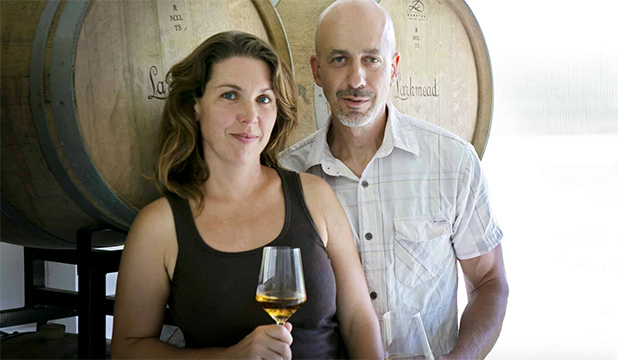
There are ciders from different countries and also ciders from different parts of the United States. Are there distinctive styles in each of these regions? And what contributes to the stylistic differences?
Well, there's definitely styles in different parts of the country and in different parts of the world. If you are sort of a cider aficionado or somebody who's getting into cider you'll know that France and Normandy and Spain and England all have very, it's a broad-brush statement, but they all have ciders that you could identify as coming from those countries, if you're familiar with their cider-making style. Why French cider often has a lot of barnyard in it and has a lot of bittersweet fruit. That is a lot of tannins and low acidity. Why that has evolved into their stereotypical taste, I'm not sure. Why Spanish ciders have a lot of acetic acid as part of their ciders, I'm not sure. But it's something that you can spend years kind of having fun tasting through.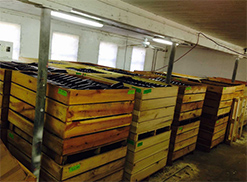 And you work with 40 different types of apples. So are there primary apples that are the apples that are kind of the workhorses of your region? And if you were to go to the Hudson Valley, are they different apples? How do you decide what apples you use?
And you work with 40 different types of apples. So are there primary apples that are the apples that are kind of the workhorses of your region? And if you were to go to the Hudson Valley, are they different apples? How do you decide what apples you use?
To answer the first part of your question, whether there's workhorse apples for cider making endemic to the Finger Lakes as compared to the Hudson Valley, really the resurgence in cider making is so new that what varieties people are using as their workhorses is just based on the grower's A) guesses about what they would like when they plant it, and B) probably more so the answer, what apples are available to them when they start their cideries. Because, frankly, most cider production starts with the cidery and not with planting an orchard and waiting years for the apples that you think are going to be good to start falling from the trees.
And what are the apples that you work with in the Finger Lakes? The main ones?
I wouldn't say, there is any Finger Lakes apple. There's a hotbed of cider-making in the Finger Lakes. There are like five cideries that we're very comfortable with and friendly with. And it's a great cider region. But there isn't an apple that's common to the different cideries, because A) there's a fair amount of buying in of apples, and B) none of us have planted apples any longer ago than maybe 20 years ago. I could say what our main varieties are.
For bittersweets, our main bittersweet apple is Ellis Bitter. It's an English bittersweet. For a base, another main apple of ours is Golden Russet. Another base, main apple is Northern Spy, for us. We love Porter's Perfection, which we have. We love Frequin Rouge, which is a French bittersweet. But, for us, it is also an experiment because my wife planted our first apples about 18 years ago with her dad. And it's years before you understand what grows well in your region and what you like for your cider. 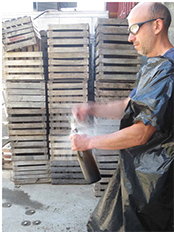 How long does it take for a tree to mature into something where you can use the fruit?
How long does it take for a tree to mature into something where you can use the fruit?
Five years is a good, reasonable expectation. There's different tree-growing or training methods that can cause a precociousness earlier, and also there's different rootstocks, which are known as being more precocious, that is yielding earlier. So it can be as early as the third year after... They call it the third leaf, or third year after you transplant it into the ground.
And I've read somewhere that due to the kind of increase in popularity of cider in the United States there's almost a dearth of cider apples (including a 2018 report from Cornell University). Is that correct?
Totally correct. I mean, there's some available. The only real source that I know of is Poverty Lane Orchards or Farnum Hill, in New Hampshire, for true cider varieties. And they grow great cider apples. That's what I'm aware of, anyway. There might be some other producers. But our partner's brother has a nursery called Cummins Nursery, and they ship thousands of cider trees out, actually every year. And we always wonder where they're going. And so they are being put into that ground. There's some growers that we know have put like 9,000 cider varieties into the ground. I don't know what's gone on with them, but I think at some point they are going to become available.
And you asked about variation within the United States of sort of cider aesthetic. I think the East Coast is very interested in... sounds a little controversial, but is really interested in growing cider varieties and sourcing cider apples specific to cider-making, as compared to the West Coast that is more into amendments.
T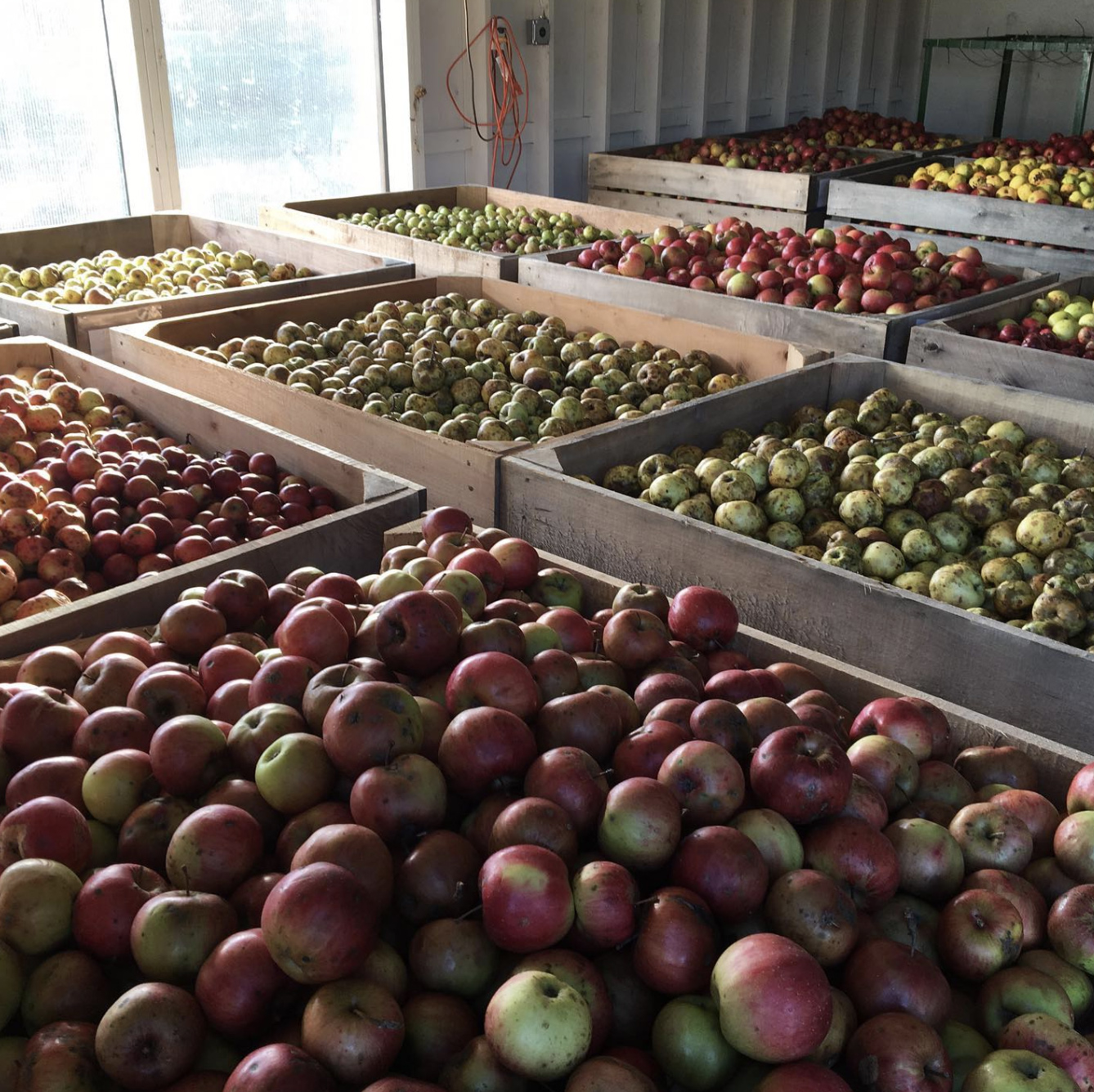 hat means combining apples and...
hat means combining apples and...
Well, that means like... Yes, getting dessert fruit and then adding pine tips and stuff like that to it, as compared to growing wine grapes, or the equivalent in the form of apples.
And what kind of styles do you have in the Finger Lakes? And would that be different from Vermont or the Hudson Valley?
It's also like my response to is there a common apple between the Finger Lakes producers and the Hudson Valley producers. I can only say that the Finger Lakes producers seem to be interested in apples that are specific for cider-making. I love Redbyrd, in the Finger Lakes. I love Farnum Hill, in New Hampshire. I like West County, in Massachusetts. But if you were to ask if the New England producers like West County and Farnum Hill have something in common, I wouldn't say, necessarily, they do other than that they're not making sweet cider and that they're making it from apples that they grow, and that type of thing.
So do you say there's almost more diversity in cider taste than there would be in wine, where people are generally working with more similar source material?
I think the cider industry has a massive footprint, and it goes anywhere from what used to be Bartles & Jaymes wine coolers that I remember from when I was a teenager to the most expensive French wines. That is the case with cider today. The majority of it's piled up in a heap on the six-pack sweet concoction. And then there's producers on the other end that I compare to wine producers, who make it like wine, and who are essentially trying to pull out of the apple what great winemakers are trying to pull out of the grape. Not necessarily like Concord grape, lollipop, but those flavors and aromas that you get from fermenting characteristics of an interesting apple.
And you mentioned that the more sophisticated ciders tend to be blends.
Well, I think one important thing, or one of the important things to have in a cider is to have mouthfeel, and longevity, and structure. And those tannins that you get from this group of apples called bittersweets does produce just a solidly tannic cider. And it is great, as type of cider, when it's made by the French or in a certain style. But I do think, having the perspective of a Chablis or something, that's just something that you think is just great with food, and well balanced, and isn't something that's just trying to hog the limelight because it's so striking. So with the blends, you can take bittersweets and blend them with sharps and then apples you think have really great aromas, and achieve some sort of symbiosis, and all them kind of work together to create something unique?
Sort of like a relationship that creates a greater whole.
Do you go to England and look at how they're doing things?
Totally.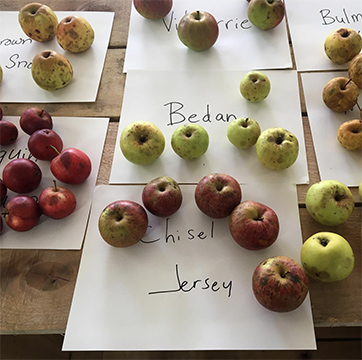 Is it something that is like wine, where a winemaker will be very, say, "Oh, we're traditional. We make things in a certain way," or is there more of a focus on innovation and evolution?
Is it something that is like wine, where a winemaker will be very, say, "Oh, we're traditional. We make things in a certain way," or is there more of a focus on innovation and evolution?
My wife did go to England when she first started Eve's Cidery. I wouldn't say that we're trying to emulate any particular style. All of our bubbly ciders are done with the Champagne method, and that wasn't because we have a high regard for Champagne necessarily, it just achieves what we want with the bubbles, nice small, persistent bubbles. We basically make cider that we like. And so what goes into your palate, into what you like. We don't have the money to travel, but we do try ciders the are imported from other parts of the world. Oliver's from England is terrific. I do like French ciders, of course. I'm starting to like Spanish ciders a lot more. And I think it's infiltrated our tastes. For example, we do tolerate, in some of our ciders, a little barnyard, which I think I've gotten from French ciders that we do like. Whereas it used to be that our ciders had to be really, really clean.
And in terms of the growing of the apples, is it something where organic is a difficult practice within apple growing? What level of organic viticulture exists in the cider world?
We're certified organic through NOFA. There's very, very little organic cider production on the East Coast. I think on the West Coast, where there's these very, very dry areas it's just much easier to do it. The difficulty in growing organic, I think, is probably more challenging than conventional here on the temperate East Coast. And it's not the only way to go, but, for us, it's what we think is best for us.
Find the following books on Amazon:
The Cider Revival: Dispatches from the Orchard by Jason Wilson
Ciderology: From History and Heritage to the Craft Cider Revolution by Gabe Cook
Banner by Piers Parlett














